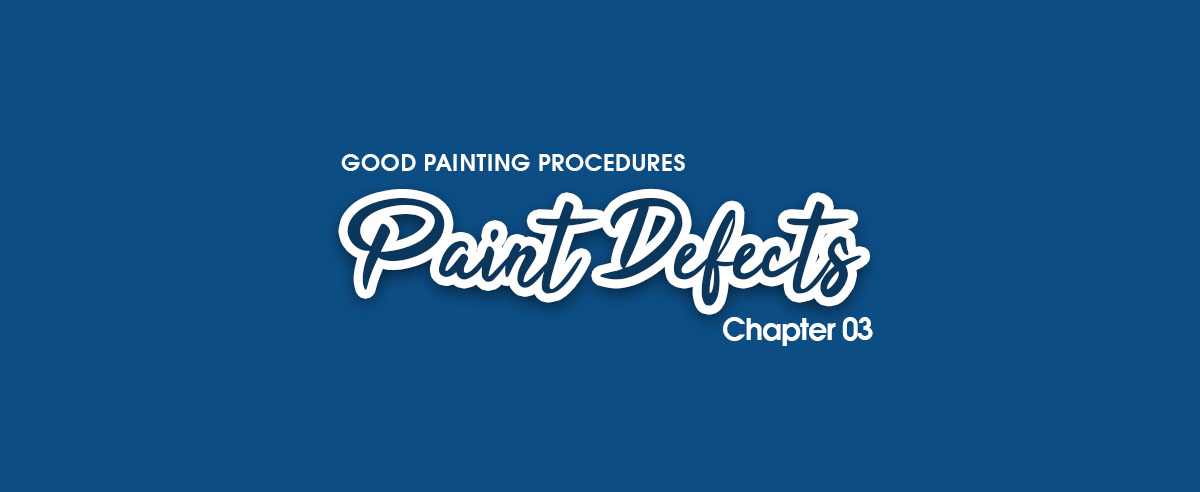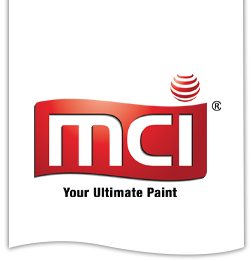Good Painting Procedures – Chapter 3: Paint Defects

Paint Defects
Defects in paint can be resulted by numerous causes. In some cases, defects occur at the same time therefore the causes are difficult to determine and the solution to the problem is rendered more difficult. It is most ideal to identify and determine the cause(s) of defects before designing solutions to it. While paint defects can also be due to unsuitable paints being specified on the wrong surface, the more frequent ones are caused by operative error such as surface preparation; and the preparation and application of paints.
Types of Defects
There are many defects in Paints. These are generally categorise into one of the following types:-
- Common Defects arising during paint storage (Table 1A);
- Common Defects arising during application, drying and curing (Table 1B);
- Common Defects developed on coatings during service life.
Common Defects arising during Paint Storage

Common Defects arising during Application, Drying and Curing

Common Defects developed on Paints during Service Life
Some common defects developed during service life are:-
- Discolouration and Fading;
- Peeling and Flaking;
- Algae and Fungus Growth.
However, defects such as chalking, saponification and yellowing can accompany or be the cause of discolouration and fading.
Discolouration and Fading
Some possible causes for this phenomenon are:-
a. Migration of Substrate Matter
Cements – Migration of water-soluble salts from cement/sand mixture to the surface, facilitated by moisture drying process. The crystallization of these water-soluble salts on the wall surfaces (efflorescence) causes the discolouration. The alkaline nature of these salts also attacks the pigment or binder that has poor resistance to such chemicals (alkaline attack) leading to discolouration.
- The above can be confirmed by checking alkalinity of affected area with pH paper. The pH paper, after dipping in water and placed against the substrate, changes colour. These colours correspond to numbers in the Universal Indicator chart, reflecting the Alkaline level of the substrate. Recommended level is between 6 – 9.
- Remedial action includes ensuring that water seepages, if any, are repaired, the substrate is sufficiently dry and repainting is carried out with alkaline-resistant paint.
- Sometimes there may be stains that keep appearing even after several coats. This is the result of contamination in the substrate. Seal off with a cement compatible oil-based Sealer and repaint when dry. In most persistent cases, Epoxy paint has been used with good success but at a higher cost.
Woods – Wood-based stains e.g. oil and wood gum, can appear and discolour the paintwork. They are more obvious for lighter colours. Remedies include preparing the surfaces as described in Chapter 2 Paint Systems under Surface Preparation and applying a coat of Aluminium Wood Primer to seal the surfaces. Repainting with Undercoat and Topcoats and observing the recommended recoating intervals will help to ease the problem.
Metals – Contaminants from rust, dirt or oil can discolour the paintwork. This is normally minor and may be left as it is unless contaminants have affected adhesion. The remedy is to employ good surface preparation and repaint.



b. Quality of Pigments & Binders
Pigments – There are generally two classes of pigment, i.e. organic and inorganic pigments. The inorganics are normally mineral-based and have good resistance to chemicals and weathering over a long period, but provide the duller shades. Organics give vibrant colours like reds, oranges, yellows, violets, pinks. They are processed from organic compounds and are generally susceptible to chemical attacks and fading. Modifications in their chemical structures have greatly improved these shortcomings. However, higher prices have to be paid for paints that use these special pigments. If fading occurs on a suspected organic pigment colour paint, the best recommended remedy is to prepare the surface and repaint with more durable colours. Sometimes rain water can leave light streak marks. This may be due to pigments with water-soluble surfactants being water-sensitive and can be eroded by water. Some low quality emulsions are more prone to this problem. The solution is to waterproof with transparent coating, or repaint with a higher quality paint.
Binders – Binders or resins can change chemically through weathering or attack by chemicals. This change will alter its look, resulting in a colour change of the paint. Properties like gloss, drying time, and service life will also be affected. For example, an alkyd resin paint that has undergone saponification. The destructive action of the alkali converts the oil in the paint to soap, leading to discolouration with a paint film that dose not dry and peels easily. This occurs especially when painting alkyd enamel paint on new concrete surface.
Yellowing – Yellowing becomes apparent in white and lighter shades. It originates from the solvents, pigments or other ingredients especially certain driers under the influence of light, heat or atmospheric contaminants. For instance, Alkyds containing fatty acids derived from the drying oils yellow to some degree in the dark. The remedy for yellowing is to paint with more durable compatible non-yellowing type of paint. For instance, if a surface uses polyurethane paint yellows, it can be repainted with a non-yellowing polyurethane paint.
Chalking – The paint becomes powdery as it weathers, is another example leading to discolouration and fading. Chalking is not objectionable in moderation; however, it is not acceptable if it appears to be excessive. It prevents accumulation of dirt and provides a suitable surface for eventual repainting, provided it is well brushed down and cleaned off. Excessive or rapid chalking is probably due to binders not resistant to weathering.



Peeling and Flaking
a. Moisture Problem
The problem of moisture has already been emphasised. On the wall, the capillary pressure created by moisture is capable of pushing the paint film off the wall. Paints which allow moisture through may reduce this force but are not guaranteed to be defect-free as the type of paint and level of moisture content and pressure are factors to be considered. The following are steps to tackle moisture peeling.
- Check moisture content of defective areas and confirm whether it is from water added during mixing of cement or seepage. If moisture content is inconsistent with the age of the building, then do not rule out the possibility of internal or external seepage.
- Water is usually accompanied by peeling, stain marks, algae growth or soft paint. Check both peeled surface and the immediate surrounding adhering paint film. The paint film will retain more water than the peeled areas.
- Water seepage should be repaired and walls allowed to dry before painting with a desired paint system.
b. Incorrect Paint System
Cement – Poor alkali-resisting basecoats that are easily degraded by strong cement alkali will chalk or powder beneath the Topcoat and cause the Topcoat to peel. This can be further aggravated by moisture or UV (Ultra-Violet light from the sun). Confirm this by checking the pH value (with pH paper). Rub basecoat surface (exposed on peeled areas) with finger and observe amount of powder removed. Both pH and powder should be high and severe respectively. Follow through the following steps for remedial action.
- Prepare surface paying particular attention to washing away of powder (chalked paint).
- Patch any surface defects with a durable putty.
- Coat a layer of alkaline-resistant solvent-based Sealer.
- Allow ample drying time.
- Recoat with an alkaline-resistant paint, e.g. Acrylic water-based paint, Acrylic solvent-based paint or Polyurethane.
Woods – In the case of timber, possible reasons for peeling are aging of wood and paint, use of low penetration primer, use of inflexible patching compounds on joints or bleeding of wood resin. Here are some corrective steps.
- Remove unstable paint film.
- If wooden surface is exposed, prime with Aluminium Wood Primer, 2-pack Polyurethanes or Epoxies are also suitable.
- Sand all surface until smooth.
- Clean off dust and residue.
- Recoat with suitable paint (refer Chapter 2 Paint Systems, Table 3B Easy reference chart for selecting Paint Systems for Wood Surfaces).
Metals – Non-ferrous metals such as aluminium, zinc coated (galvanised), stainless steels, normally pose a problem of adhesion. One of these surfaces may have been coated only to find out that severe peeling occurs after a few months of weathering. This can be corrected with the following:-
- Remove all paint films.
- Treat surface with a coat of Etching Primer (Polyvinyl Butyral / Phosphoric acid type).
- Recoat with a suitable paint system (refer Chapter 2 Paint system, Table 3C Easy reference chart for selecting Paint Systems for Metal Surfaces).
a. Poor Surface Preparation
Failure to remove unstable matter during surface preparation causes peeling of latter coatings. This can be remedied by either removing all coatings or treating peeling as they occur. However, this can be a very costly exercise. Often, the peeling wall is left untouched until peeling has stabilised and then treat the affected areas only, assuming that the rest is stable. Where appropriate, use high pressure water-jet washing to remove all unstable paint film. It is also possible that peeling can result from unstable plasters. This can be easily identified by looking behind the peeled paint to see whether the characteristic grey plaster material has come off with the paint. The following are some points for treating this problem:-
- Remove all unstable base matter which may include plaster, corroded metal bases. Make good with putties suitable for the respective substrate, e.g. cement-based for re-plastering and Nitrocellulose (NC) or Polyester putties for metals.
- Prime surface with penetrative solvent primers to further stabilise the base.
- Recoat with recommended Paint Systems and observe recoating interval.



Algae and Fungus Growth
Fungi require nutrients such as Carbohydrates, Nitrogen, Sulphur, Potassium and Phosphorous for their development. Algae are green chlorophyll-containing organisms which meet their energy requirements by photosynthesis. Both algae and fungi will only flourish where there is ample supply of moisture. Algae grow almost exclusively outdoors as they require sufficient sunlight for photosynthesis. Growth of algae on external surfaces can be observed by their distinctive colours. Green, reddish and black signify the different stage of growth. In harsh tropical climate of high humidity, rainfall and abundant sunshine, buildings are especially prone to the proliferation of algae. Factors that enable growth are:-
a. Moisture source and retention;
b. Source of nutrients;
c. Easy retention of spores;
d. Sufficient sunlight for photosynthesis.
The following are suggested steps to remedy algae problems:-
- High-pressure water-jet washing of all affected areas coupled with manual scrubbing if necessary.
- Treat surface with Anti-Algae solution to terminate growth of organisms embedded in the concrete.
- Wash again to remove any residue and allow to dry . Repair surface defects with a suitable filler or putty.
- Coat a layer of alkaline-resistant Sealer.
- Recoat with 2 layers of weather resistant acrylic paint.
